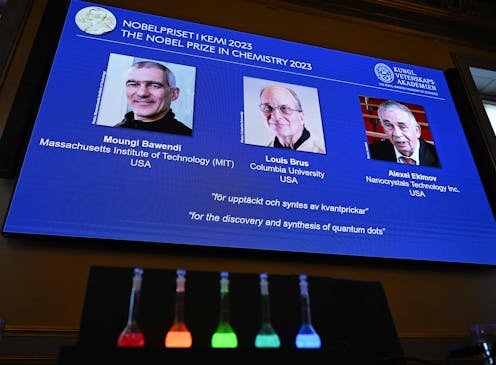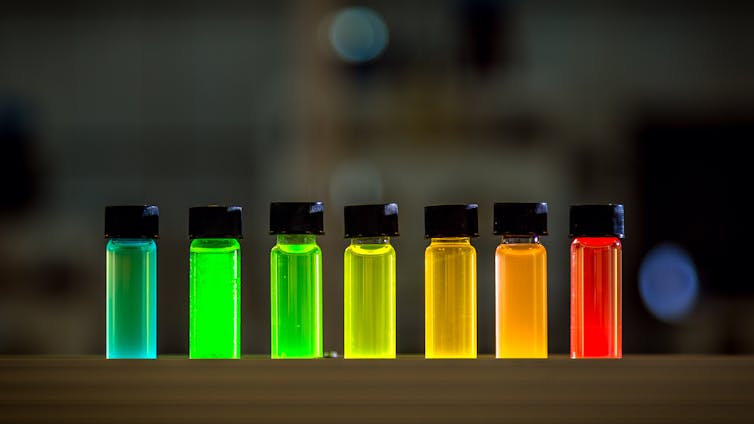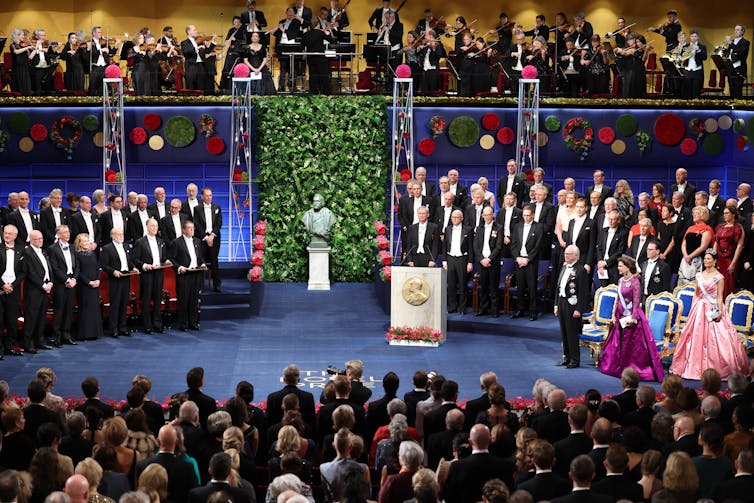
The Nobel Prize in chemistry for 2023 goes to three scientists “for the discovery and synthesis of quantum dots.” The Conversation Weekly podcast caught up with one of this trio, physical chemist Louis Brus, who did foundational work figuring out that the properties of these nanoparticles depend on their size. Brus’ phone was off when the Nobel reps called to inform him of the good news, but now plenty of people have gotten through with congratulations and advice. Below are edited excerpts from the podcast.
When you were working at Bell Labs in the 1980s and discovered quantum dots, it was something of an accident. You were studying solutions of semiconductor particles. And when you aimed lasers at these solutions, called colloids, you noticed that the colors they emitted were not constant.
On the first day we made the colloid, sometimes the spectrum was different. Second and third day, it was normal. There certainly was a surprise when I first saw this change in the spectrum. And so, I began to try to figure out what the heck was going on with that.
I noticed that the property of the particle itself began to change at a very small size.
What you’d found was a quantum dot: a type of nanoparticle that absorbs light and emits it at another wavelength. Crucially, the color of these particles changes depending on the actual size of the particle. How do you even see a quantum dot crystal, since one is just a few hundred thousandths the width of a human hair?
Well, you can’t see them with an optical microscope because they’re smaller than the wavelength of light. There are ways to see them too, using other types of specialist microscopes, such as an electron microscope. And a common way of demonstrating them is to line up a row of brightly colored glass flasks each with a solution of different sized quantum dots inside it.

One of your fellow laureates, Alexei Ekimov, was a Russian scientist, and he’d actually observed quantum dots in colored glass, but you weren’t aware of his findings at the time?
Yes, that’s right. The Cold War was going on at that time, and he published in the Russian literature, in Russian. And he wasn’t allowed to travel to the West to talk about his work.
I asked around among all the physicists, was there any work on small particles? I was trying to make a model of the quantum size effects. And they told me no, nobody’s really working on this. Nobody had seen his articles, basically.
I was part of the U.S. chemistry community, doing synthetic chemistry in the laboratory. He was in the glass industry in the Soviet Union, working on industrial technology.
When I eventually found his articles in the technological literature, I wrote a letter to the Soviet Union, with my papers, just to say hello to Ekimov and his colleagues. When the letter came, the KGB came to talk to the Russian scientists, trying to figure out why they had any contact with anybody in the West. But in fact they had never talked to me or anyone in the West when my letter arrived in the mail.
Have you met him since?
Yes, they were able to come out of the Soviet Union during Glasnost, this would be the late 1980s. There’s Ekimov, and then there is his theoretical collaborator Sasha Efros, who now works at the U.S. Naval Research Lab. I met them as soon as they came to the U.S.
Listen to the interview with Louis Brus on The Conversation Weekly podcast. Each week, academic experts tell us about the fascinating discoveries they’re making to understand the world and the big questions they’re still trying to answer.
One of the issues with quantum dots, when you first observed them, was how to actually produce them and keep them stable. Then, in the 1990s, your fellow laureate, Moungi Bawendi, figured this out. What do you think is the most striking thing that you’ve seen quantum dots used in so far?
Usually when a new material is invented, it takes a long time to figure out what it’s really good for. Research scientists, they have ideas, you might use it for this, you might use it for that. But then, if you talk to people in the actual industry, who deal every day with manufacturing problems, these ideas are often not very good.
But the knowledge that we gained, the scientific principles, could be used to help to design new devices.
As far as first applications, people began to try to use them in biological imaging. Biochemists attach quantum dots to other molecules to help map cells and organs. They’ve even been used to detect tumors, and to help guide surgeons during operations.

And as scientists kept working to synthesize quantum dots, the quality of the particles kept improving. They were emitting pure colors, rather than distributions of light – like maybe red with a little bit of green, or maybe red with some pink. When you got a better particle, it would be just pure red, for instance.
So then people made the connection to the display industry – computer displays and television displays. In this application, you want to convert electricity into three colors: red, green and blue. You can make up any kind of image, starting with just those three colors in different proportions.
It takes a lot of courage. You have to invest a lot of money to develop the technology, and maybe at the end of it, it’s not good enough, and it will not replace what you already have. And there’s a lot of credit due to the Samsung Corporation in Japan. Hundreds of billions of dollars were invested in the technology of these particles to get them to the point where they could begin to manufacture displays and flat-panel TVs using quantum dots.
Your work is an example of the importance of basic research, of being curious, trying to solve mysteries without a particular endpoint or industrial application in sight. What message would you have for a young chemist starting out today working on such basic research?
The world is a huge place, and you could do basic research in a huge number of different areas. You want to pick a problem where, if you are spectacularly successful and you actually discover something really interesting, it might have some application in the world.
For better or for worse, you have to make a choice in the beginning, and it takes some intuition.
A good way to do it is you pick a subject that you know is important to technology, but there’s no understanding of the science at the present time. It’s a complete black box. Nobody understands the basic principles. That kind of problem, you can begin to take it apart and look to see what the basic steps are.
What changes for you now that you’ve won the Nobel Prize?
Well, this Nobel Prize, for better or for worse, has a special meaning in people’s minds all over the world. Yesterday when the mailman came I happened to be at the front door and he recognized me because my face was in the local newspaper. And he said, “I’ve never shaken the hand of a Nobel laureate before.”
For better or for worse, this is where I am right now, in a special category whether I like it or not. I still have my office in the university, but I don’t have a research group. I’m trying to leave that to the younger people. So this recognition probably means less for my research than it would if I was 40 years old.
I have received congratulations by email from a number of people who won the prize in past years. Their main recommendation is you must learn to say no. People will ask you to do all kinds of crazy things, and your time will be entirely taken up with these honorific university visits and giving little speeches. In order to have a real life and to be productive, you have to say no to all of these extraneous invitations.

And they also told me to have fun in Sweden! It’s an extremely elaborate schedule of events for that week in December when this award ceremony is. Extremely fancy. American culture, physics culture is different – if you win a prize from the American Physical Society, it’s a very low-key event. You just show up in an auditorium. It’s not even necessary to wear a suit.
So I will take my family, my grandchildren to Sweden and we’ll try to enjoy this as a great vacation.
Louis Brus does not work for, consult, own shares in or receive funding from any company or organization that would benefit from this article, and has disclosed no relevant affiliations beyond their academic appointment.
This article was originally published on The Conversation. Read the original article.







